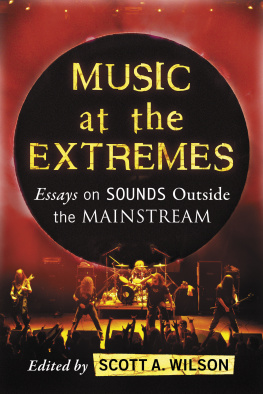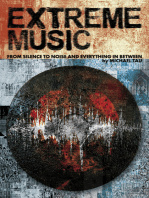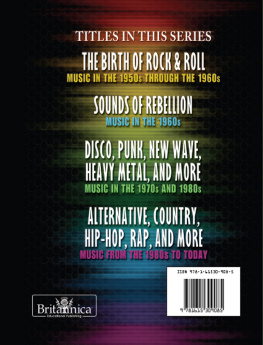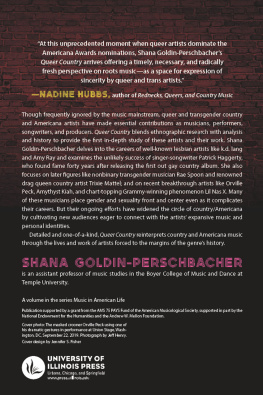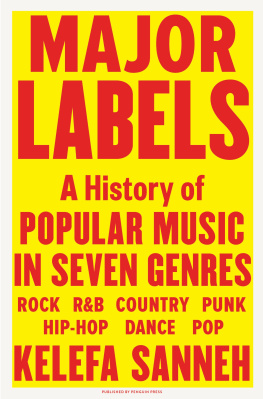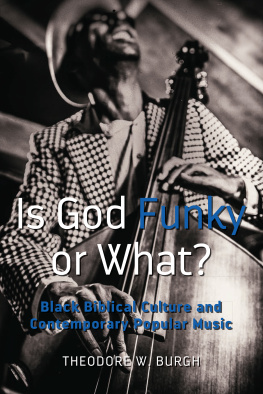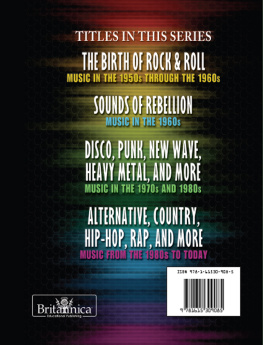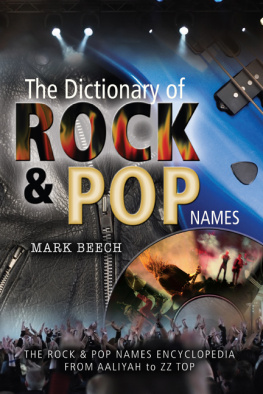
Music at the Extremes
Essays on Sounds Outside the Mainstream
Edited by Scott A. Wilson

McFarland & Company, Inc., Publishers
Jefferson, North Carolina
LIBRARY OF CONGRESS CATALOGUING DATA ARE AVAILABLE
BRITISH LIBRARY CATALOGUING DATA ARE AVAILABLE
e-ISBN: 978-1-4766-2006-0
2015 Scott A. Wilson. All rights reserved
No part of this book may be reproduced or transmitted in any form or by any means, electronic or mechanical, including photocopying or recording, or by any information storage and retrieval system, without permission in writing from the publisher.
On the cover: Cannibal Corpse at the 9:30 Club in Washington, D.C., on October 3, 2007 (photograph by Chris Buresh)
McFarland & Company, Inc., Publishers
Box 611, Jefferson, North Carolina 28640
www.mcfarlandpub.com
Preface and Acknowledgments
This book started with a conversation as, Im sure, many such projects do. I had participated in a panel discussion at the 2013 PCA/ACA conference in Washington, D.C., investigating extreme music with a group of similarly minded people and we were bemoaning the lack of scholarly material dedicated to the rigorous exploration of the music we had just finished discussing. Sure, there were a smattering of articles and, in the case of some of the metal genres, an emerging critical literature located around the work of a handful of authors (all of whom are referenced throughout this volume), but overall we noted that fans of extreme or unpopular music were left in the cold or, perhaps more appropriately, the dark. That conversation became this book and this book was always intended to both meet the need for critically rigorous interrogation, and to foster further discussion into the genres and bands that feature in the essays that follow.
What emerged through the initial call for expressions of interest, and through the long process of editing and revision, was something entirely unexpected, or perhaps more accurately, not expected if one is familiar with the small amount of literature that exists and to which many of the authors in this volume respond. In short, and as is explored in far more detail below, these essays represent a remarkable diversity: diversity, first, in the genres and sub-genres, the hybrid and mutant expressions of creativity that these authors seek to explore. To call for writing on extreme or unpopular music is to pretend, at the very least, that there is either a continuity within which all of these expressions must sit, or a template to which they all conform. Yet these essays all attest to the fact that this music outside of the mainstream (more on that later) is diverse in form and diverse in fascination. Even within the relatively restrictive articulations of the genres and sub-genres themselves, there is extraordinary flexibility, movement and growth. To be a fan of, or a musician in, any of this music means, at the very least, that one participates in highly volatile conversations with all of the demands, facets and extremes of popular culture. This then marks the second kind of diversity that emerges in these essays: those of us who profess to be fans of the many forms of extreme music, just as those who are fans of any form of popular culture, are different from each other in ways that the restrictions of such labels as extreme or unpopular cannot capture. In the essays that follow, these diversities are given space, made visible and critically exploredsome, crucially, for the first time.
Thus, what becomes visible in these essays is the fact that, at least in relation to the putative mainstream (which is never far from sight in what follows, even if never referred to directly), against which many of these genres and sub-genres are defined, there are a series of highly complex, highly articulate conversations, arguments and feuds played out between participants who are enormously literate in the terms of their various discourses. As is made clear over and again in these essays, within these genres and their troubled (and troubling) offspring, the standard notions of a popular (or populist) discourse simply does not apply. These fans and musicians are entirely in control of what they are doing, and absolutely in charge of the ways in which they encounter their lived experience with and through this music. So what the essays in this volume seek to do is to take entirely seriously, and encourage a continued rigor in, the ways in which such scholarship continues to develop in regard to this music and to those who find pleasure, meaning, identity and satisfaction within it.
I note in passing above that a number of the essays that follow provide explorations of genres, bands, musicians and practices that have not been explored in print before. Others refer to extant material (such as it might exist), but all of this work develops an intense and vital critical voice that isand I use this term deliberately and often because of its academic significancerigorous in both its appreciation and exploration. This volume was designed from the outset to provide an opportunity to continue the conversations around unpopular and extreme music that already occur in a multitude of places and forms, and all involved with this volume eagerly await the continuation of the discussions that we begin in the essays that follow.
* * *
This collection is very much a joint effort and I owe an enormous debt of gratitude to those authors who worked so hard, and who endured my own ludicrous schedule (and its concomitant delays) with grace and good humor, in order to produce this volume. To Damion, Shayna, Alessandro, Andrew, Janus, Anna, Brenda, Tai, Saul, Kirsten, Gregory, Sabatino, Kyle, Rahima, Thomas and Josephthank you. I am honored to be able to present your incredible scholarship to the world.
I am enormously grateful to Myfanwy Fanning-Randall for her critical eye and rigorous interrogation of language, spelling and grammar. If not for her work, her expertise and skill, this volume would have never been completed.
Thank you to those artists and individuals who provided the illustrations in this volume. In particular we would like to thank Merle Allin, for the photos of his brother GG, Susan Lawly for the Whitehouse images, Century Media for the images of Turisas, and Southern Lord Records for the image of Wolves in the Throne Room. We are similarly extremely grateful to those bands, artists and labels who gave permission for the use of lyrics in the essays that follow.
I am overwhelmingly grateful to Katie Gallof for suggesting that I take my idea for this volume to McFarland.
My sincere and heartfelt thanks to my friends and comrades, with a very special thank you to Glenda Keam, Jim Gardner, Samuel Holloway, Mark Taylor, Caro Alexander (of Unity Booksthe best indie bookshop in the country), Caroline Grose and Greg Walker. Thank you all for your friendship and support.
As always, love to my wonderful sister, Robyn.
Finally, I offer my thanks and apologies to Teresa Callaghan; it was my idea that as I worked through each authors essay I would playloudthe music to which they refer and around which their essays revolve. As a consequence, shes endured, and sometimes enjoyed, more than I could ever have reasonably expected and, through it all, supported and assisted without complaint.
Introduction
Hush, May I Ask You All for Silence?
Scott A. Wilson
Next page
